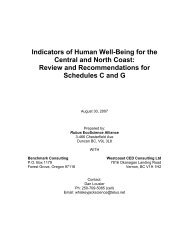West Babine Sustainable Resource Management Plan
West Babine Sustainable Resource Management Plan
West Babine Sustainable Resource Management Plan
You also want an ePaper? Increase the reach of your titles
YUMPU automatically turns print PDFs into web optimized ePapers that Google loves.
The <strong>Babine</strong> River is considered Classified Waters in order to maintain opportunities for “any<br />
class of angler to participate in a fishery in a relatively unspoiled, uncrowded environment” (BC<br />
Fisheries, 2002). The classified waters system was established to recognize high quality trout<br />
rivers in BC, in particular steelhead rivers, and to maintain angling opportunities for resident<br />
anglers in those waters. The classification prescribes the level of angling use and guiding activity<br />
and allocates use between classes of anglers (BC residents, other Canadians, non-Canadians).<br />
Class 1 rivers are premier waters where the level of guided use is restricted.<br />
Summer-run steelhead populations travel up the Skeena during the summer months and arrive in<br />
the <strong>Babine</strong> system in late summer and fall to spawn. The principle spawning ground for<br />
steelhead is outside of the plan area and runs from the counting fence to Nilkitkwa lake. The<br />
largest concentration of steelhead occurs just below the outlet of <strong>Babine</strong> Lake (GTOWPG,<br />
2002). Within the plan area, steelhead spawning has been documented in the Hanawald and<br />
Shelagyote Creeks, and in the headwaters of the Nichyeskwa Creek (Gottesfeld et al, 2002).<br />
Sports fishing also occurs on the lower Shelagyote River and on some of the lakes in the <strong>West</strong><br />
<strong>Babine</strong>. Other sport fish include Chinook, Sockeye, Coho, bull trout, Dolly Varden char, lake<br />
trout, and rainbow trout. Within the plan area, bull trout primarily occur in the Shelagyote River<br />
and its tributaries.<br />
The <strong>Babine</strong>-Nilkitkwa lake system supports the largest sockeye salmon population in Canada<br />
(GTOWPG, 2002). The <strong>Babine</strong> population has accounted for 75 – 95 per cent of the Skeena<br />
sockeye production, averaging more than 3.8 million adult fish annually since 1990 (DFO,<br />
1999). Much of this high productivity can be attributed to artificial channels in the Fulton River<br />
and Pinkut Creek, outside of the plan area, which typically account for more than 70 per cent of<br />
smolt production from the <strong>Babine</strong>-Nilkitkwa lake system.<br />
The <strong>Babine</strong> chinook are one of the most important of the Skeena chinook populations<br />
(GTOWPG, 2002). The <strong>West</strong> <strong>Babine</strong> provides rearing and migration habitat for most of the<br />
Chinook populations in the <strong>Babine</strong> drainage, with documented spawning runs on the Shelagyote<br />
River and Nichyeskwa Creek (DeGisi, 2000 as cited in GTOWPG, 2002). Pink runs represent<br />
approximately 4% of the total Skeena watershed escapement (Gottesfeld et al. 2002) and Chum<br />
are present but are not abundant. <strong>Babine</strong> coho stocks are currently depressed in abundance and of<br />
high conservation concern (GTOWPG, 2002). Coho do not spawn in the plan area.<br />
The <strong>Babine</strong> fishery is of very high importance to the Gitxsan and Lake <strong>Babine</strong> Nation.<br />
Traditionally, the fishery provided food, trade goods, as well as cultural expression and<br />
connection to ancestral practices (GTOWPG, 2002). The Gitxsan salmon fishery at Kisgegas<br />
Canyon is thought to have been the largest traditional aboriginal fishery in the Skeena watershed<br />
(GTOWPG, 2002), while the major Lake <strong>Babine</strong> Nation fishery occurred outside of the plan<br />
area, around Nilkitkwa Lake.<br />
Fishing continues to be an integral cultural practice and sustenance activity for the Gitxsan and<br />
Lake <strong>Babine</strong> Nation. Salmon is a fundamental food source and the sockeye run is, and has been,<br />
particularly important to the First Nations. Fort <strong>Babine</strong> Enterprises operates an Excess Salmon to<br />
Spawning Requirement (ESSR) fishery targeting sockeye jacks harvested from the <strong>Babine</strong> at the<br />
counting fence outside of the plan area, primarily by dip-netting (Gottesfeld et al, 2002). In<br />
March 2004 Page 55

















